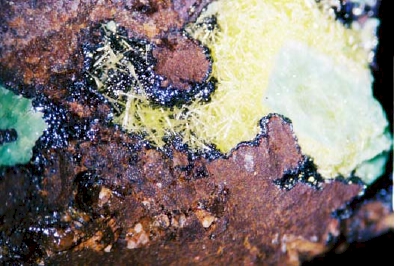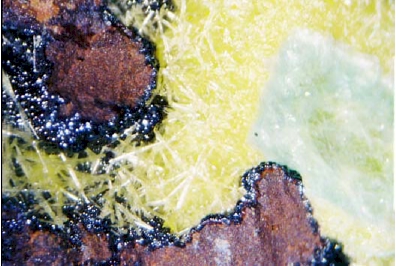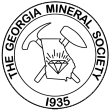Secondary Uranium Minerals – Part 1
by
Dave Babulski, Ed.D.
("Tips and Trips", Vol. XXXV/8, August 2006, page 12 & 13.)
Hello everyone, this month the Micromount Corner will begin a series on secondary uranium-bearing minerals. Generally speaking, secondary uranium minerals are brightly colored and make for some striking additions to a micromount collection. This month we will investigate three secondary uranium minerals that are often found together. These are the minerals, meta-uranocircite, schoepite and ianthinite. As is often the case with mineral micromounts, more than one mineral species can be found in a given specimen. Figure 1 is a photomicrograph at a magnification of 30X of the minerals meta-uranocircite, schoepite, and ianthinite. The specimen is from the Krunkelbach Valley Uranium Deposit, Menzenschwand, Black Forest, Baden-Wurttemberg, Germany. The specimen was photographed through the microscope with Kodak ASA 400 color print film with a four second exposure. The microscope light source is a white light emitting diode.

Figure – 1
In Figure 1, the light green waxy looking mineral is the meta-uranocircite. Uranocircite is a hydrated barium uranium phosphate. The meta form is a dehydrated form of the mineral. This mineral is characterized by its green color and waxy appearance and tabular crystals that look very similar to the uranium bearing mineral autunite. The tabular greenish crystal of meta-uranocircite is surrounded by masses of bright yellow acicular crystals of the mineral schoepite. This mineral is a uranium oxide hydroxide hydrate and is highly radioactive. Both the metauranocircite and the schoepite are deposited on a dark brown resinous botryoidal matrix of the mineral ianthinite. Ianthinite is a complex uranium oxide deca-hydrate. All of these secondary uranium bearing minerals are on a light brown matrix of uraninite. Figure 2 is a closer view of the specimen photographed at a magnification of 60X

Figure – 2
The Krunkelbach Valley Uranium Deposit was a series of uranium bearing barite-flourite veins hosted by granite. This deposit was worked until 1990. The dumps have now been removed and the area has been landscaped. The mineral uranocircite is named for its uranium content and the Greek for falcon – referring to Falkenstein, Saxony, Germany, where the mineral is commonly found. The mineral schoepite is named for Alfred Schoep (1881-1966), Belgian mineralogist who studied uranium mineralogy. The mineral ianthinite is named for the Greek ianthinos, “violet” as this mineral often has a somewhat purple coloration. Mineral species that are alteration products of primary uranium bearing minerals offer some interesting color and challenges to a micromount collection. Because these secondary minerals are often highly radioactive, care must be taken when placing the specimens in your micromount collection. Some mineral species are very sensitive to radioactivity. Some collectors house all their radioactive specimens in special shielded containers. I encourage you to investigate these colorful mineral species.

Figure – 1
In Figure 1, the light green waxy looking mineral is the meta-uranocircite. Uranocircite is a hydrated barium uranium phosphate. The meta form is a dehydrated form of the mineral. This mineral is characterized by its green color and waxy appearance and tabular crystals that look very similar to the uranium bearing mineral autunite. The tabular greenish crystal of meta-uranocircite is surrounded by masses of bright yellow acicular crystals of the mineral schoepite. This mineral is a uranium oxide hydroxide hydrate and is highly radioactive. Both the metauranocircite and the schoepite are deposited on a dark brown resinous botryoidal matrix of the mineral ianthinite. Ianthinite is a complex uranium oxide deca-hydrate. All of these secondary uranium bearing minerals are on a light brown matrix of uraninite. Figure 2 is a closer view of the specimen photographed at a magnification of 60X

Figure – 2
The Krunkelbach Valley Uranium Deposit was a series of uranium bearing barite-flourite veins hosted by granite. This deposit was worked until 1990. The dumps have now been removed and the area has been landscaped. The mineral uranocircite is named for its uranium content and the Greek for falcon – referring to Falkenstein, Saxony, Germany, where the mineral is commonly found. The mineral schoepite is named for Alfred Schoep (1881-1966), Belgian mineralogist who studied uranium mineralogy. The mineral ianthinite is named for the Greek ianthinos, “violet” as this mineral often has a somewhat purple coloration. Mineral species that are alteration products of primary uranium bearing minerals offer some interesting color and challenges to a micromount collection. Because these secondary minerals are often highly radioactive, care must be taken when placing the specimens in your micromount collection. Some mineral species are very sensitive to radioactivity. Some collectors house all their radioactive specimens in special shielded containers. I encourage you to investigate these colorful mineral species.

Copyright © Georgia Mineral Society, Inc.
